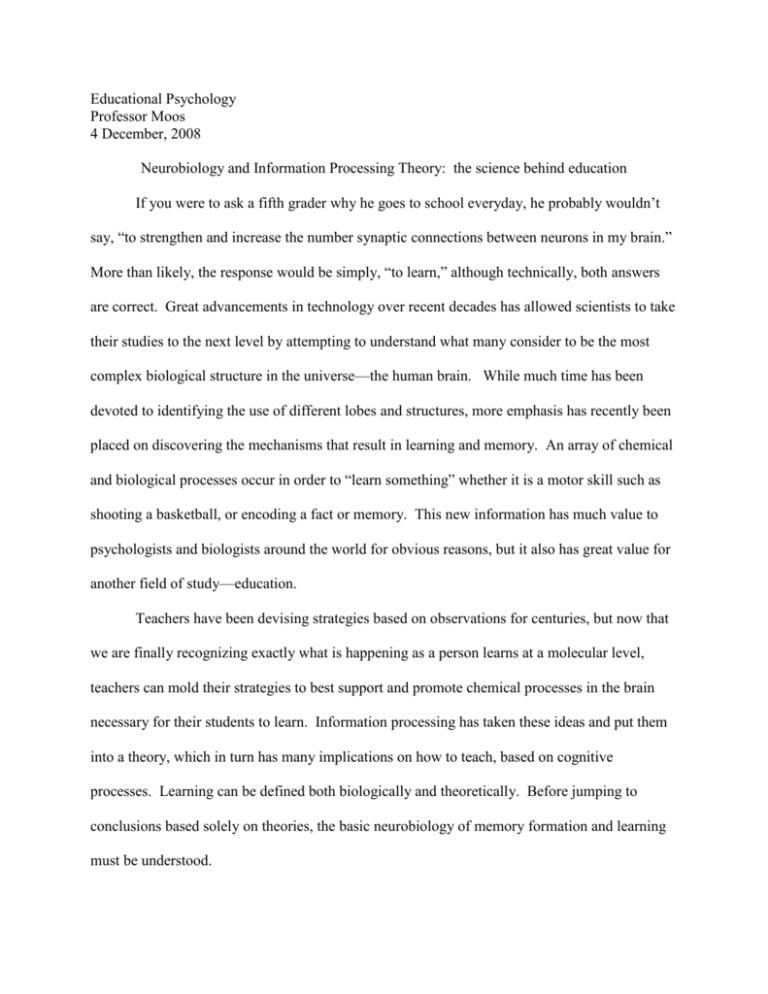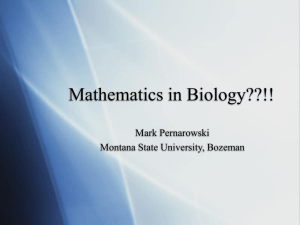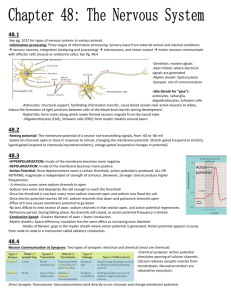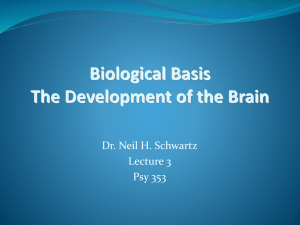
Educational Psychology
Professor Moos
4 December, 2008
Neurobiology and Information Processing Theory: the science behind education
If you were to ask a fifth grader why he goes to school everyday, he probably wouldn’t
say, “to strengthen and increase the number synaptic connections between neurons in my brain.”
More than likely, the response would be simply, “to learn,” although technically, both answers
are correct. Great advancements in technology over recent decades has allowed scientists to take
their studies to the next level by attempting to understand what many consider to be the most
complex biological structure in the universe—the human brain. While much time has been
devoted to identifying the use of different lobes and structures, more emphasis has recently been
placed on discovering the mechanisms that result in learning and memory. An array of chemical
and biological processes occur in order to “learn something” whether it is a motor skill such as
shooting a basketball, or encoding a fact or memory. This new information has much value to
psychologists and biologists around the world for obvious reasons, but it also has great value for
another field of study—education.
Teachers have been devising strategies based on observations for centuries, but now that
we are finally recognizing exactly what is happening as a person learns at a molecular level,
teachers can mold their strategies to best support and promote chemical processes in the brain
necessary for their students to learn. Information processing has taken these ideas and put them
into a theory, which in turn has many implications on how to teach, based on cognitive
processes. Learning can be defined both biologically and theoretically. Before jumping to
conclusions based solely on theories, the basic neurobiology of memory formation and learning
must be understood.
Neurobiology: changes in the brain that result in learning
According to Harvard neuroscience expert Dowling (2004), approximately 100 billion
neurons, along with even more supporting cells and structures, compose the brain. This number
of neurons is typically reached between birth and the first six months of life, and is fixed—the
number of neurons in the brain actually decreases as life goes on. Clearly learning is not a result
of an increase in neurons, but instead is caused by increased and strengthened connections
between neurons (Dowling, 2004). How are these connections strengthened?
The hippocampus (a region of the brain tucked underneath the temporal lobe) and
surrounding cortical areas are largely responsible for the creation of new memories. A strong
stimulus serves as input to create a change in electrical current with cells in the hippocampus.
This depolarization of the pre-synaptic cells causes neurotransmitters to be released across the
gap between the cells known as the synapse. These neurotransmitters bind to receptor proteins,
which allow a wave of positively charged molecules into the post-synaptic cell. These positively
charged ions, particularly Ca2+, bind to a series of enzymes. These enzymes facilitate protein
synthesis. These newly formed proteins, which are often channels, branches or entirely new
synapses are made in the post-synaptic cell, and are added to the post-synaptic cells to make
them stronger (Dowling, 2004). Figure 1 shows a diagram of the synapse connecting two
neurons, using serotonin as the neurotransmitter.
A strong synapse means heightened sensitivity to neurotransmitters between the presynaptic and post synaptic cells. In other words, less effort is required to activate memories. In
order for this strengthening to occur, a stimulus must be induced repeatedly over a period of
time. It is also important to note that, “If a strong stimulus is repeated several times over a
Figure 1 Depolarization of pre-synaptic and post-synaptic cells. The release of neurotransmitters—in this case,
serotonin—triggers a series of reactions in the post-synaptic cell, which result in the formation of new proteins used
to rewire and strengthen synaptic connections. Diagram from: <http://www.airlinesafety.com>
relatively short period, the potentiation of the synapses lasts for days or even weeks. A single
strong input stimulus, on the other hand, lasts for one to three hours” (Dowling, p. 95-96). Two
major concepts can be drawn from the knowledge of these processes: a need for strong,
meaningful stimuli to spark the synaptic reactions, and repetition of these stimuli to strengthen
those connections. Strong connections result in long term memory formation and automaticity,
which will be discussed later in the paper.
Before these long term memories are created, the information must first be practiced and
organized in the working memory (see Information Processing Theory). Working memory
appears to function through temporary synchronized firing patterns that emerge between related
networks in the thalamus (current information) and the cortex (related memories) (Dowling,
2004). These firing patterns are limited—our working memories can only hold a certain amount
of information for a very short time. This is the basis of one of one of the cognitive learning
theories—information processing.
Information Processing Theory: putting science into perspective
As stated by Eggen and Kauchak (2007) Information Processing Theory is, “the most
prominent cognitive learning theory of the 20th century, and has important implications for
teaching today” (p. 200). The basis of this theory is that in order to learn, information must be
stored in the brain, and have the ability to be pulled back out for further analysis or performance.
The Information Processing Theory explains how stimuli are chosen and organized for storage,
and retrieved from our memory for further processing. Information processing uses a model
(Figure 2) based on the study of cognitive processes to show how the stimuli move through our
minds to become either lost or encoded in our long term memory.
Figure 2 Information processing model (Eggen and Kauchak, 2007). A stimulus causes a student to recognize
information using sensory memory and carry it over to working memory where it can be temporarily processed and
organized. If practiced enough, this information is encoded into the long term memory, where it can be retrieved for
further encoding.
According to the Information Processing Theory, there are three types of memory, each
more permanent than the next. All stimuli first “pass” through our sensory memory, which
briefly (1-4 seconds) holds stimuli from the environment until it can be processed. If the
stimulus is meaningful, it will be transferred into the working memory. The working memory is
the conscious part of our processing system, which holds information until it is either transferred
to the long term memory, or lost. The working memory can hold approximately seven “chunks”
of information, and for about 20 seconds.
Finally, the long term memory is the permanent
information storage department. It can hold endless amounts of information, sometimes for a
lifetime. This theory allows us to come to several conclusions, which have many implications
for teaching strategies.
Implications of neurobiology and information processing on teaching
Attracting attention
In order for the learning process to begin, the student must first have attention focused on a
stimulus. A stronger stimulus calls for the release of more neurotransmitters, and will result
stronger synaptic connections.
Begin the lesson with an attention getter—reenact a portion of history, tell a joke, or demonstrate
a scientific experiment. Attention can also be maintained using simple strategies. For example,
telling the students, “pay attention to this next part, it is very important” will focus much of their
attention on you. Another simple strategy—calling on student by name, rather than addressing
the whole class—is one of the most powerful attention getters out there (Eggen and Kauchak,
2007).
Reducing cognitive load
Rewiring the brain to increase connections between concepts requires enough space in the
working memory to organize these thoughts. The working memory has a limited capacity of
approximately seven items. Because of this, reducing the cognitive load is necessary for
reorganizing and encoding into the long term memory to occur.
Many strategies can be implemented to free up space in the working memory. Presenting
information in a meaningful and organized manner is one of those strategies. One method
known as “chunking” organizes a set of information into a more meaningful context (T F O J H
O U F U E R L T H Y = THE FOURTH OF JULY). One way of chunking is to teach a lesson
focused on “the big picture” rather than on a set of definitions. For example, don’t simply ask
the student to match the structure of a flower with its definition. Have them draw the flower out,
label structures, and identify interactions between structures and how they work together to carry
out basic functions.
Developing a routine, being well prepared for each lesson, and being consistent with
rules and classroom policies will allow students to worry less about the learning process and
more on the actual learning.
Make meaningful connections
Information that is meaningful to a student allows them make connections with other areas of the
brain, speeding up and increasing the complexity of the learning process.
People construct knowledge; it is not simply recorded in their mind. They make connections
between past experiences and new information to make sense of it. Showing students the
importance of learning a new concept by applying it to real life is one way to make meaningful
connections. Another is to relate concepts to background knowledge. For example, if you are
teaching about the immune system, and you know that Susie recently had the flu, ask her about
the symptoms such as a fever and why the body uses it as an immune response.
If a student has no experience with the flu, create that experience for them—show a video or
have them read a story. Whatever that experience is, it will create background knowledge that
serves as a foundation for learning.
Repetition of new information is key
“People learn to do well only what they practice doing” (Dowling (p.92). The more a student
discusses and works with the information or task at hand, the better he will become at it. Just
like shooting a basketball. You may start out shooting with horrible form, but can perfect your
shot by putting in hundreds of hours in the gym.
Studying is the most common method of practicing new concepts. Students must encounter new
information for the first time, but should see it again several times in meaningful context.
Assigning a chapter to read, discussing it in class, and taking time to review that knowledge
during class will cause the student to encode and retrieve information into and from the long
term memory, activating specific neurons for each set of concepts. The repeated stimulation of
those neurons will increase the strength and number synaptic connections, decreasing retrieval
time and promoting learning.
Give Feedback
“One of teachers’ most important roles is to provide students with feedback that can help them
arrive at more sophisticated understanding” (Sylwester, 1995). In order to give feedback,
teachers must first assess their student’s knowledge. This can be done formally, for example,
through an exam or presentation, or informally through open ended questions during class time.
Whatever the method of assessment, feedback should be immediate (or as soon as possible) and
should identify all misconceptions. If a student correctly understands a concept, the teacher
should reinforce this understanding with praise or assurance so that the student can encode their
ideas with confidence.
Biologically, learning is defined as:
The strengthening and increase in numbers of synaptic connections between
neurons in the brain, which also connect to areas in the brain involving
emotion and communication.
These physical changes result in:
-Automaticity—minimal to no mental effort required to activate long term
memory to retrieve information.
-Increased temporary storage in working memory.
According to the information processing theory, implications for teaching include:
-Getting attention. Need a strong stimulus to induce chemical mechanisms.
-Reducing cognitive load.
-Making meaningful connections between concepts.
-Practice, practice, practice—correctly. Feedback is needed to clarify
misunderstandings.
Figure 3 Summary of this paper: connections made between learning described in biological changes, information
processing theory, and the implications this has for teaching strategies.
While there have been many recent findings neuroscience, there is even more left to be
discovered. Scientists around the world named the 1990’s “the decade of the brain,” but
increases in technology are hinting that the 21st century will make even greater advances. By
being aware of these new findings and explaining them through theories such as information
processing, teachers will understand the biological implications of why they are teaching in a
certain way. And perhaps, as more insight is gained on learning, they will be able to create new
strategies or modify old ones to best facilitate a learning environment, so the students will have
the greatest chance at a successful education.
References
Dowling, J. E. (2004). The great brain debate. Washington, D.C: Joseph Henry Press.
Eggen, P. & Kauchak, D. (2007). Educational psychology: Windows on classrooms.
Upper Saddle River, NJ: Pearson Prentice Hall.
Philp, R. (2007). Engaging ‘tweens and teens. Thousand Oaks, CA: Corwin Press.
Sylwester, R. (1995). A celebration of neurons: an educator’s guide to the human brain.
Alexandria, VA: Association for Supervision and Curriculum Development.










